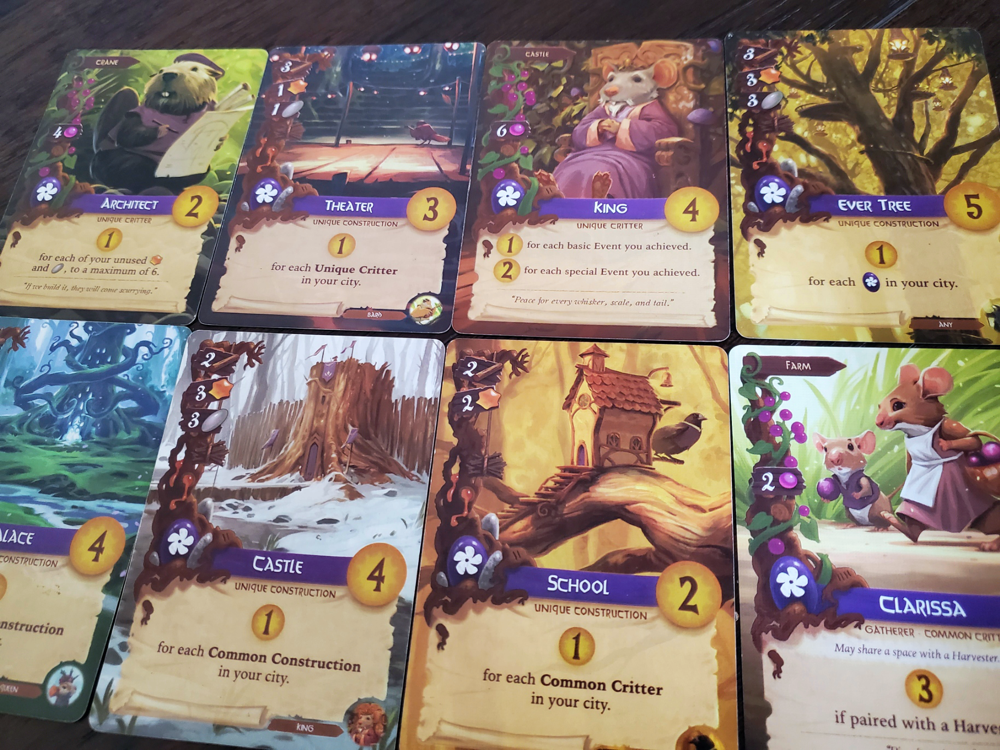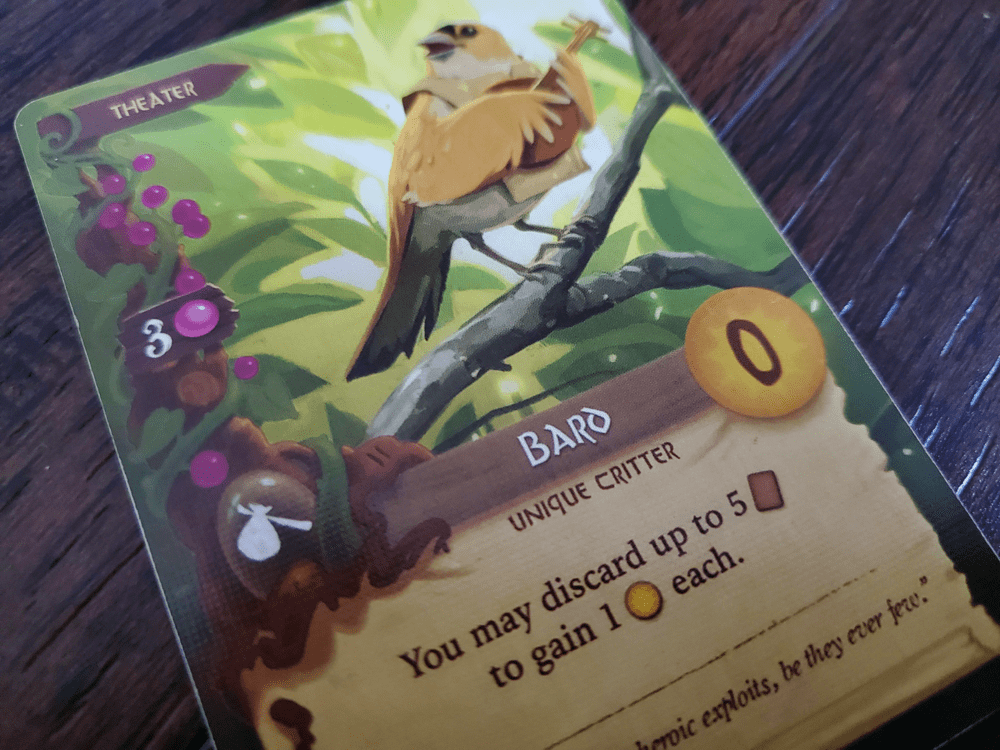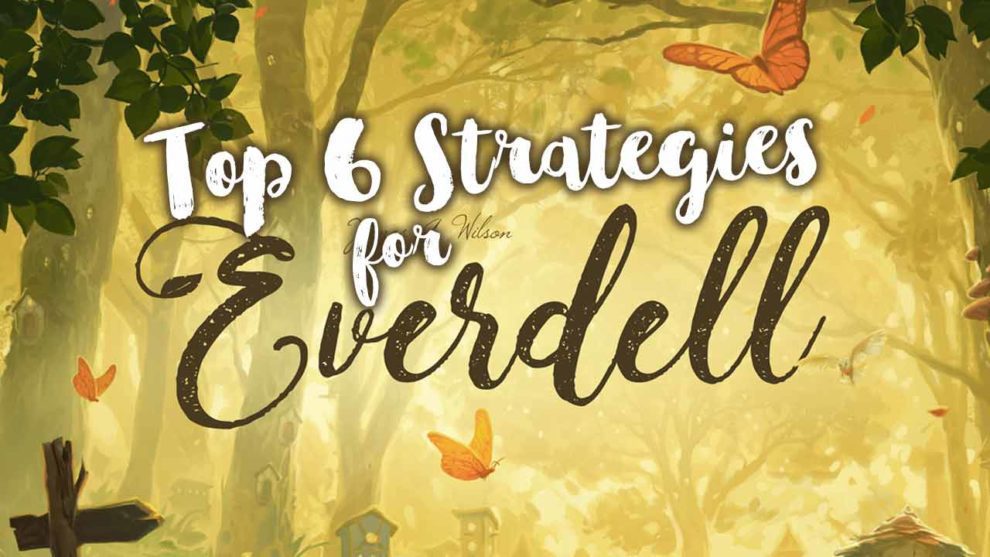The rules couldn’t be any easier: either place a worker, play a card, or prepare for season. See?
Our first game of Everdell, at three players, lasted around three hours. At the time, it was the longest game I had ever played. My daughter and I now regularly play in just under an hour. But every time I introduce my first and most beloved 10/10 to a friend, the clock hands start stretching again. It takes time to get to know the Meadow.
The greatest chronological culprit is the deck of 128 Critter and Construction cards that comprise the deck of the base game. Not only are they beautiful, but they are all useful both on their own and in conjunction with other cards in the deck. With as many as eight cards in hand and eight in the Meadow, players start to stand still (but time keeps on a-rollin’).
The second chronological culprit is the breadth of decisions that consume a limited number of turns. With eight worker placement options along the River, another four in the Forest, plus Basic events, Special events, the Haven, and, eventually, the Journey, there is much sifting to do. Let’s remember there are only 15 total workers to place before the game is over.
I had no doubt that Everdell was special from our first play. But I have invested time, effort, and, well, time to befriend this favorite. I’ve forgotten what it was like to have my eyes glaze over at the possibilities (or perceived lack thereof), but I’ve seen it enough in other players now to recognize that a few pointers might help ease into the world.
While some of these tips are quite specific, most are merely principles—propped up where possible by examples—to help make the Meadow a bit more friendly. The last thing I want is to think that anyone could walk away from my best inanimate friend on account of not feeling welcome, so let’s get acquainted.
Spotting Winter Gems
On the one hand, the first of Everdell’s four seasons should be a breeze. With only two workers to place among all those locations, how painful could it be? After all, sometimes it’s over in the blink of an eye. On the other hand, with only two workers and a desire to get something rolling before preparing for season the first time, how much pressure is there on the opening turns?
One key is sifting through the 128 cards to know which are most useful in that opening round of turns. Though there are a dozen or more to choose from, getting the right resources and selecting the right card for a proper chain of events is crucial to feeling at home.
Though I’m a firm believer that nearly any card can be a great start—any card that doesn’t arise from the purple Prosperity suit, that is—there are also cards that stick out above the rest and are quite affordable with only two workers. This may be cheating, but I’m going to give a top six within this Top 6:

- Most obviously, a Farm is a solid start. The berry it gives is nice, but the Farm is also an open door to other useful cards—the Harvester/Gatherer combo, the General Store, and the Barge Toad. Green cards in general will produce the first time you prepare for season, and are therefore great starting points, but Farms top that list.
- The Crane is a ticket to a discount on a better Construction. And at a cost of only one pebble, you can’t miss with this play.
- The Innkeeper is a worthwhile pursuit to gain a potent Critter on the cheap, especially if you are dealt one in hand and can first go after an equally affordable Inn.
- The Clock Tower is one of my favorite Winter plays because it guarantees additional resources at each turn of Season. The earlier it is played, the better.
- The Courthouse (or even the Judge) can be a great first cog in a productive engine. The earlier these blues hit the table, the more they will produce. A Winter Courthouse means six, eight, or even ten resources if you lean into Constructions.
- The Shopkeeper serves the same function as the Courthouse, but with berries for Critters.
Caring About Synergies
One of the struggles with Everdell is knowing that synergies exist between Construction and Critters. But a game with that many cards offers no promises that you’ll ever see the card matches you want—especially at two players. Perhaps you view this as a reason to decry the whole endeavor and toss the $60 base game into the nearest pond. Personally, I view it as part of the design and, therefore, something that requires proper emotional preparation.
Repeat after me in your best Stuart Smalley voice: There are at least a handful of cards I”ll want today that I will never see, and that’s…OK.
One of the dirty little secrets of Everdell is that there are plenty of times you shouldn’t engage the synergy because it just doesn’t fit what you have going on in your city. There are times you’ll want the Critter without the corresponding Construction and vice versa. Early in the game, it always feels like you won’t fill the city, so you’re desperate to get the Miner Mole to work your precious Mine and you’re furious when you don’t see it. Little do you realize your opponent has already discarded two behind your back! Fear not—your city will be fine. There are countless other ways to score.

In some games, the Wanderer’s cards are far more helpful than the Lookout’s workaround in the Forest. Other times the Ranger’s free placement of a worker far outweighs the Dungeon’s ability to bury cards that have overstayed their welcome. On the flipside, you’re almost never afforded the time to sit on the Crane waiting for the Architect to appear before you have to discard it in favor of a better Construction. This is most true in the purple suited Constructions and their ties to lucrative cards like the Queen and the Bard.
I would argue the more important synergy in the game is between the Forest and the cards. The three or four variable resource locations of the Forest are often the enemy of a favorite strategy. If those locations are giving you cards but not berries, you have to adjust if you love chasing the mightiest Critters. If resin is more abundant, you might want to give a second look to some of those Constructions you typically ignore. Remember, the Critters are fairly flexible—you should be, too.
Equipping the Engine
Knowing how the suits work is quite helpful. Greens, intuitively, produce resources. Blues bend the rules and require constant attention. Reds alleviate pressures by opening alternate locations, but they occupy your workers. Tans are insta-boosts (and usually have the coolest characters. How is that fair?!). Purples serve the endgame. Yes, I know the suits have names and not just colors, but that quiz doesn’t come up until you’ve played at least a half-dozen games. For now color references will do.

Based on the early contents of the Meadow, the opening hand, and the interference of your opponents, you’ll want to get some sort of engine going, preferably employing multiple suits to keep your options open (along with the door to Basic events later):
-
- Blues are best played early and must be viewed with the long haul in mind. You don’t want too many, mostly because they’re not worth all that many points. Grab one or two and let those dividends pay.
- Reds must be viewed with sacrifice in mind—workers are precious, so you won’t be able to use too many. But they often have a massive reward. The Queen will get you two or three solid cards for free if you find her early enough. The University might help you shift strategies mid-course by selling off a card or two. The Chapel stores up coins for scoring.
- Purples become more valuable throughout the game as they push players toward gathering specific cards and resources. Knowing your Palace makes the Monastery worth an extra point might make it more useful than that Resin Refinery. Likewise the Architect might alter your use of pebbles and resin. Getting a couple of these cards into play by Summer might lighten the brain pain.
- Greens occasionally feed into one another or allow for the brief raid of a neighbor. With a trigger point in Spring and Autumn, these are a viable part of any engine.
- I’ve not forgotten the Tans, but they are purely tactical. They strike in a moment and then they are gone. Counting on them too deeply only leads to heartache (remember, you might never see a Postal Pigeon), though they are vital to success whenever they avail themselves.
Embracing the Darkness
As I was learning Everdell, the cards that took the longest to embrace were the darker cards, the cards that removed a card or meeple from the game permanently. The Dungeon allows the imprisonment of a Critter to discount a card, but at the cost of the unfortunate Critter’s points and benefit. The Ruins have a zero point value, but serve to re-gather the resources for a card (or cards in the case of a paired set like the Harvester/Gatherer or some of the later expansion combos). The University also has this darker spin—sometimes education must tear down in order to rebuild.
Ditching a costly card, such as the Castle, might serve your strategy well if your Common Construction count is low, or the EverTree if you haven’t acquired multiple purples. The resources from cards like these can easily translate to multiple late-round effects.

Even the Monastery with its lifetime commitment of a meeple took time for me to accept. But there are places for all of these cards as you look across the landscape of your city and your needs.
The subtractions work a little like the synergies: no card is so sacred that it can’t be sacked in the name of victory. Recognizing that the Clock Tower has reached its limit of usefulness, or shackling a dear friend once the Ranger unlocks the second Dungeon might be the best play. These aren’t easy decisions, but they occasionally open the door to a host of unexpected possibilities. Never underestimate what pieces might fall into place from just one more open spot in your city.
(Mostly) Ignoring the Special Events
The first edition base game of Everdell includes a series of Special Events that are painfully specific. For example, it would be lovely to get four points and a worker back because you’ve acquired the Chip Sweep and the Clock Tower, but remember our friend Stuart Smalley. Those cards may never see the light of day. Yes, collecting the Inn and the Bard will net you an opportunity for six points, but what are the chances they’ll both visit your city?
If you’ve acquired a later edition or the Big Box version of Everdell, you might have the new Special Events that are more generic, offering bonuses for acquiring a set number of a certain suit of card. These are less intimidating, more possible, and they might just give you something to aim for. Using these from the start is definitely the more friendly route.

If you’re on the first edition, though, you can’t view the hyper-specific Special events as essential to victory. They are nice, but that’s all they are. I know, they make the King less appealing (but only a bit, he’s valuable anyway) because he rewards achievement, but that’s the way the cookie crumbles.
The Basic Events are far more interesting in a typical game, anyway. With only a few cards required to meet the target, these tokens introduce a bit of tension as players roll through the seasons at slightly different paces. It’s best to look over the Specials, recognize the cards when they rear their little heads (or chimneys in the case of Constructions) and then evaluate whether they are worth the chase. Just don’t lose sleep over it. I’ve won plenty of games without even looking at that branch of the EverTree.
Timing, Timing, Timing
Everdell operates on a unique calendar. Because each player progresses through the seasons at their own pace, it is possible for one player to be hanging out in Winter still while others are in Spring—or even Summer. Understanding the seasonal status of players around you might help you predict some of their movements.
When someone prepares for Summer just as you’ve made it known you could really use that Chapel card in the Meadow, you might lose your chance. When one player breaks into Autumn on the board, everything changes. Workers become expendable for more Events, the Monastery, or permanently occupying a spot in your Inn. Knowing this just might influence a decision or two. This is hard, nigh impossible, in the first play, but it is a pivotal dynamic of the game.
Gaining the rhythm of how you gain workers is also important. Two workers in the Winter is a potential challenge. Sometimes you get two turns. Then again, I’ve had eight or more turns in Winter because the right combination presented itself. Know this, though: just because that happens for your opponent doesn’t mean the game is over. The player who managed to play four cards in Winter has four less spots in their city before the engine really starts firing. A packed city isn’t always a blessing with so many turns remaining.
Finally, recognizing the way timing affects the important synergy—the Forest and the cards—is helpful. Realizing a player is running out of steam and might have to prepare for season might mean a needed spot is opening up. That knowledge translates into knowing whether to hold off or jump ahead to gain an edge.
I realize I’ve not given anything specific to look for here, no specific cards to help or timing tips to ensure you’ve got it all right. That’s by design, because the only surefire way to gain a sense of the timing is to give time to Everdell. You’ve got to try stretching out a season or two to see what happens. You’ve got to finish the game four or six turns before anyone else at least once to see the benefits and drawbacks of rushing (which often accompanies that bloated Winter). You’ve got to spend workers in the Summer for Basic events to see how it changes everything.
The Final Word
Some games are efficiency puzzles—just figure out the puzzle, score the most, and win. Everdell is certainly NOT that. It is a living environment and must be treated as such. As opportunities come and go with the cards, it will disappoint you sometimes (hopefully not too often in your first play), yet at other moments it will blow your mind through generosity. It is utterly unpredictable yet perfectly playable. I’ve never enjoyed adapting as much as I do in the Meadow.
Though I feel this way about many games, it is Everdell that taught me the lesson: avoid chaining yourself to the strategy that seems most obvious or the one that won you your first game. Yes, a load of green cards seems like a winning path, but you really should try winning without it. Embrace the darker cards if they’re uncomfortable to you and see what they have to offer. Mess around with the rhythms and timing, even if only in the name of learning a hard lesson. Play the Bard as your first card—I dare you.

The key to success in Everdell is enjoying Everdell. Perhaps that sounds like a trite sentiment, but it’s true. And I mean enjoying Everdell for what it is: a game that will present you with unwanted challenges and then wink at your ill-advised attempts to cope. My favorite and most memorable games are the ones where I did the unexpected and learned how some strange combination worked for (or against) me.
Take the advice with a grain of salt. There is no surefire path, especially as you start to press into the wide swath of Everdell expansion material. Press into the charm of Everdell first and you just might find a welcoming friend at the table.
















“[. . .] or even shackling the Ranger into the Dungeon he helped unlock, might be the best play.”
Sorry, man, but that’s against the rules! The Ranger *cannot* be placed into the second slot of the Dungeon that is unlocked by having the Ranger. Says so in the official FAQ and rules clarifications! You may want to amend your advice.
Good catch! I’ll check it out and revisit the article.